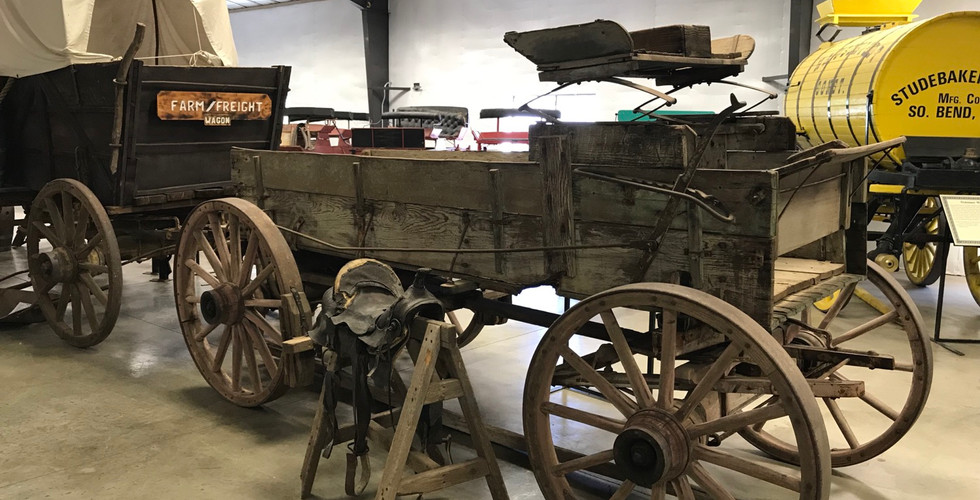Angels Camp, CA - 7-13-19
Today we pulled out of our campground in Angels Camp and began heading north towards Plymouth on California 49, also known as the Golden highway. As we headed out of town we thought we would stop at the Angels Camp Historic Museum.

The small storefront that is visible from the street gives you the impression that this is a small museum, but you would be sadly mistaken to pass it by. We were fortunate to find street side parking nearby where we could park our motorhome with our car in tow. The admission is $7 for adults and $5 for children and all proceeds go to support this non-profit museum that is operated by the City of Angels group. About 1/3 of the exhibit space is dedicated to information about Samuel Clemens - aka Mark Twain. Clemens spent time with the Gillis Clan in nearby Jackass Hill. (https://www.sierranevadageotourism.org/content/mark-twain-cabin-no-138-california-historical-landmark/sie373EBF719DEE63A23)
He was there hiding out from the law because he had helped a friend of his jump bail. There are copies of letters that Clemens had sent to his Mother and Sister from his time spent near Angels Camp. It was a very depressing time for Clemens. He had left his home in Missouri where he was a riverboat pilot, a well paying job. Some accounts suggest that he was fired but the information in the museum suggests he left the job to go west with his older Brother, in part to avoid participating in the Civil War. His brother went on to Carson City, where he was instrumental in setting up the Nevada state government. Samuel went on further west. He spent time in the gold country, first speculating and investing in different gold mining operations, none of which produced. Unfortunately, much of his investments were done on margin and when they didn't pay off, he found himself deep in debt. He would go on to San Francisco where he became a reporter for a newspaper. It was there that he realized his passion for writing and his desire to be a writer.
I had always wondered why he used the name Mark Twain. One account we read in town suggested that he used the name Mark Twain when he submitted his short essay about the Jumping Frog because he was being sought by law enforcement officers. The museum suggests a different reason, one that sounds more plausible to me. The museum indicates that Clemens was a straight news reporter for a San Francisco paper. He would also write humorous essays. His humor stories were penned under the name Mark Twain to differentiate the writing from the news reporter. Clemens would quit his job as a reporter, because the demands it placed on his time took away from his creative writing and the publisher would not entertain any of the embellishments that were to become a hallmark of Twain's work.
Around 1865, Twain was visiting the Angels Camp hotel and listening to a story told by the bartender there by the name of Simon Wheeler. In one of his letters to his Mother and Sister he related that he had heard a hilarious tale and if he could write and re-tell the story just the way that Simon Wheeler delivered it "the whole world is going to know of the famous jumping frog of Calaveras County". His prophecy was correct. The story was picked up and published around the world. Twain would go on to write a collection of short stories to help paint a vivid picture of the west.

The museum sits atop the site of the old Angels Gold mine. The mine was named after the city's founder Henry Angel. The small building that is visible from the street occupies a number of exhibits that are dedicated to the history of the city of Angels Camp and of course one of its most notable patrons - Mark Twain. The museum property winds down a gentle hill that was know as China Gulch. Its name comes from the fact that this was an area where Chinese immigrants were relegated to. They would pan for gold in nearby streams. That is until, the gold that could be found by panning began to pan-out. At that point, the Chinese were pushed out of this area and a "hard rock" mine was dug. This then became the site of the Angel's deep tunnel mine. This particular site sits atop a confluence of 3 different quartz veins and gold is often found within the quarts. It's hard to imagine that below this museum winds over 200 miles of hard dug tunnels winding down several thousand feet below the surface.

The large overshot water wheel that was used to power ore crushers and other machinery on the site still sits in its original spot. A long wooden flume would have directed water to the top of the wheel causing it to spin. The wheel is made of heavy cast iron and the inertia of the spinning wheel would drive axles that could be used to power different devices. Chief among them were pulleys to haul the ore out of the mine, where it would be placed into large crushing machines. The crushed rock would then be sent down a series of sluices with water where it would separate the gold from the other material. Quite a fete of engineering.
The Museum also has an old steam operated power tractor named "Ol' Beth". It was built in the early 1840's and used in mines and then later to haul timber. It remained in operation until the 1940's - over 100 years. They don't build things like that any more.

As you make your way down the property the next building is a large display of original buggies, wagons and carriages. It is one of the largest and most comprehensive collection of original pieces in California.
Continuing further down the property you get to another large building that is dedicated to artifacts that capture the mining history of the region and how that evolved to agriculture and then ranching. The Curator in that museum was explaining about the formation of the gold deposits and how the search for gold created the string of towns that dot the Sierra Foothills. Starting in Coloma the search for gold would extend to the south-east. The further to the south and east the more difficult it would become to find gold. This is why the towns become further and further apart as you work you way south down what is now highway 49.






















Comments